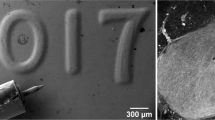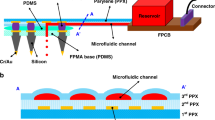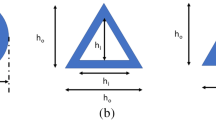Abstract
We present a microfabricated 10 by 10 array of microneedles for the treatment of a neurological disease called communicating hydrocephalus. Together with the previously reported microvalve array, the current implantable microneedle array completes the microfabricated arachnoid granulations (MAGs) that mimic the function of normal arachnoid granulations. The microneedle array was designed to enable the fixation of the MAGs through dura mater membrane in the brain and thus provide a conduit for the flow of cerebrospinal fluid. Cone-shaped microneedles with hollow channels were fabricated using a series of microfabrication techniques: SU-8 photolithography for tapered geometry, reactive ion etching for sharpening the microneedles, 248 nm deep UV excimer laser machining for creating through-hole inside the microneedles, and metal sputtering for improved rigidity. Puncture tests were conducted using porcine dura mater and the results showed that the fabricated microneedle array is strong enough to pierce the dura mater. The in vitro biocompatibility test result showed that none of the 100 outlets of the microneedles exposed to the bloodstream were clogged significantly by blood cells. We believe that these test results demonstrate the potential use of the microneedle array as a new treatment of hydrocephalus.










Similar content being viewed by others
References
Baojian X, Defeng Z, Dongfeng Y, Qinghui J, Shen G, Jianlong Z (2007) Pyramid-shaped tips based polymer microneedles for transdermal drug or nanoparticle delivery. In: 7th IEEE conference on nanotechnology, 2007, pp 287–290
Browd SR, Gottfried ON, Ragel BT, Kestle JRW (2006) Failure of cerebrospinal fluid shunts: part II: overdrainage, loculation, and abdominal complications. Pediatr Neurol 34:171–176
Chang TY, Yadav VG, De Leo S, Mohedas A, Rajalingam B, Chen C-L, Selvarasah S, Dokmeci MR, Khademhosseini A (2007) Cell and protein compatibility of parylene-C surfaces. Langmuir 23:11718–11725
Choi Y, McClain M, LaPlaca M, Frazier A, Allen M (2007) Three dimensional MEMS microfluidic perfusion system for thick brain slice cultures. Biomed Microdevices 9:7–13
Choi S-O, Kim Y, Park J-H, Hutcheson J, Gill H, Yoon Y-K, Prausnitz M, Allen M (2010) An electrically active microneedle array for electroporation. Biomed Microdevices 12:263–273
Choudhury D, Mo X, Iliescu C, Tan LL, Tong WH, Yu H (2011) Exploitation of physical and chemical constraints for three-dimensional microtissue construction in microfluidics. Biomicrofluidics 5:022203–022218
Drake JM, Kestle JRW, Tuli S (2000) CSF shunts 50 years on past, present and future. Child Nerv Syst 16:800–804
Dubowitz DJ, Dyer EAW, Theilmann RJ, Buxton RB, Hopkins SR (2009) Early brain swelling in acute hypoxia. J Appl Physiol 107:244–252
Emam M, Abashiya Y, Chareunsack B, Skordos J, Oh J, Choi Y, Kralick F, Noh H (2008) A novel microdevice for the treatment of hydrocephalus: design and fabrication of an array of microvalves and microneedles. Microsyst Technol 14:371–378
Fudge R, H. Association (2002) About normal pressure hydrocephalus: a book for adults and their families. Hydrocephalus Association
Grände PO, Asgeirsson B, Nordström CH (2002) Volume-targeted therapy of increased intracranial pressure: the Lund concept unifies surgical and non-surgical treatments. Acta Anaesth Scand 46:929–941
Jonghyun O, Gyuman K, Kralick F, Hongseok N (2011) Design and fabrication of a PDMS/parylene microvalve for the treatment of hydrocephalus. J Microelectromech Syst 20:811–818
Liu K, NiCkolov Z, Oh J, Noh H (2012) KrF excimer laser micromachining of MEMS materials: characterization and applications. J Micromech Microeng 22:015012 (11 pp)
Lollis SS, Mamourian AC, Vaccaro TJ, Duhaime A-C (2010) Programmable CSF shunt valves: radiographic identification and interpretation. Am J Neuroradiol 31:1343–1346
Loukas M, Shea M, Shea C, Lutter-Hoppenheim M, Zand P, Tubbs RS, Cohen-Gadol AA (2010) Jean Baptiste Paulin Trolard (1842–1910): his life and contributions to neuroanatomy. J Neurosurg 112:1192–1196
Papadea C, Schlosser RJ (2005) Rapid method for β2-transferrin in cerebrospinal fluid leakage using an automated immunofixation electrophoresis system. Clin Chem 51:464–470
Patwardhan RV, Nanda A (2005) Implanted ventricular shunts in the United States: the billion-dollar-a-year cost of hydrocephalus treatment. Neurosurgery 56:139–145
Po-Chun W, Wester BA, Rajaraman S, Seung-Joon P, Seong-Hyok K, Allen MG (2009) Hollow polymer microneedle array fabricated by photolithography process combined with micromolding technique. In: 31st annual international conference of the IEEE engineering in medicine and biology society, 2009, pp 7026–7029
Pople IK (2002) Hydrocephalus and shunts: what the neurologist should know. J Neurol Neurosurg Psychiatry 73:i17–i22
Rousche P, Normann R (1992) A method for pneumatically inserting an array of penetrating electrodes into cortical tissue. Ann Biomed Eng 20:413–422
Roxhed N, Gasser TC, Griss P, Holzapfel GA, Stemme G (2007) Penetration-enhanced ultrasharp microneedles and prediction on skin interaction for efficient transdermal drug delivery. J Microelectromech Syst 16:1429–1440
Surchev J, Georgiev K, Enchev Y, Avramov R (2002) Extremely rare complications in cerebrospinal fluid shunt operations. J Neurosurg Sci 46:100–102
Acknowledgments
This work is supported by the National Institute of Neurological Disorders and Strokes (grant no. 1R21NS057474). The authors would like to appreciate the technical support from Moo-Hwan Kim at Femto Science regarding RIE processing.
Author information
Authors and Affiliations
Corresponding author
Rights and permissions
About this article
Cite this article
Oh, J., Liu, K., Medina, T. et al. A novel microneedle array for the treatment of hydrocephalus. Microsyst Technol 20, 1169–1179 (2014). https://doi.org/10.1007/s00542-013-1988-4
Received:
Accepted:
Published:
Issue Date:
DOI: https://doi.org/10.1007/s00542-013-1988-4




